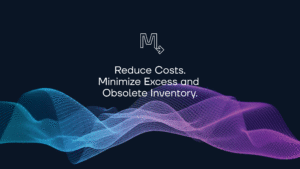The digital transformation train is leaving for Automation Station—Don’t get left behind in the digital revolution.
Traveling alone in a foreign country, I recently found myself being held hostage—by a powerful “intelligent system”.
After recently attending a large medical device logistics conference in the Netherlands, the impregnable ticket gates at the Rotterdam Central station refused to accept my just-purchased “smart chip” ticket. The ticket had just worked fine entering my departure station but was invalidated apparently after the gate sensor misidentified my rolling luggage as a second passenger. I was trapped, frustrated, and I was about to miss my flight. Of course, there were no staff present: Who needs human assistance when you have such a smart transit system?
Is your team (sales, ops, customer service) being held up by a not-so-smart system?
Are your processes being held hostage by a not-so-smart system?
This experience recalled for me three principles that stood out at the conference:
- Garbage in, garbage out
- The customer is always right
- Life (they) will find a way
The medical device industry is working hard to digitize manual processes yet extensive automation remains a distant wish for most.
It is time to work smarter too.
It is time for Movemedical.
1. Garbage In, Garbage Out (Comprehensive Processes & True Integration Create Clean Data)
Automation only works when digitizing GOOD processes.
In software development and data analytics, a philosophy to live by is “Garbage in, garbage out.” For automation to actually work (and not make things worse), issues in your supply chain process must be resolved before—or at least in conjunction with—digital transformation.
One major challenge raised by multiple presenters at the conference was that augmenting Poor Processes by Digitalizing them only results in Expensive Poor Processes, iconized by the formula:
PP x D = ExPP
(Poor Processes x Digitalization = Expensive Poor Processes)
Process issues also become compounded with digitalization, as in the popular maxim:
“To err is human–but to really foul things up requires a computer.”
Poor processes result from inconsistent, incomplete, or non-compatible communication of critical data between disparate systems or mismatched methods of input. This is obvious when using multiple modes of manual communication: emails, phone calls, texts, faxes, spreadsheets, whiteboards, post-it notes (no joke, we’ve seen it all).
But data communication issues are exacerbated when disjointed digital systems attempt to talk to one another. Unless established standards are employed (or you have unlimited expert integration development resources at your disposal), it’s a game of telephone at warp speed.
So how do you ensure the right data is being communicated?
Data communication issues virtually disappear when using a unified platform that:
- receives data input via whatever method is most convenient for the customer (field sales, warehouse operations or accounts)
- manages all field scheduling and inventory activities
- is integrated seamlessly back to the ERP for transactions.
That is the ideal, however it is all too easy to fall into the trap of blaming the customer for bad data.
2. The Customer is Always Right (User is King)
Improving processes cannot mean complicating them for the end-user.
At Movemedical we are driven by this core tenet: “User is King”, this philosophy drives everything we do. At the conference, a sentiment surfaced that automation would only be achievable once we incentivize, negotiate, or pressure the customer (anyone providing data input) to give us the right data we need to get the job done. The issue with this perspective is: instead of making sure we are as easy as possible to do business with, we are placing the onus on the customer.
For example, inventory orders that show only usage location and products without any indication of restock location or inventory type make it impossible to determine the particular processing flow required to fulfill this order. Of course, requiring the customer to give us everything on a silver platter definitely makes our job easier, but then what value are we offering?
Just like when I was in Rotterdam, where the transit system was not smart enough to perceive that my input signal indicated a single passenger with luggage (not two passengers)—when your inventory management system is smart enough to recognize inventory types and track individual pieces in and out of kits, there’s no need to inconvenience the customer in order to get the data required to complete the job.
True inventory management is smart and enables automation.
What if, instead, field inventory is accurately tracked with sufficient detail that minimal input from the customer is enough for your system to know exactly what product was used, where it came from, where or if it needs restocking, and how it needs to be billed. And then it automates all those processes behind the scenes—that’s the kind of added value that distinguishes a solutions provider from simply another device provider.
So how did I escape my predicament? I had a job to do, I had somewhere to be, and I needed to get off that train platform to do it. Even though the smart transit system had failed me, I utilized my resourcefulness, and I found a way to accomplish my task outside the system.
3. Life Will Find a Way (Proper User Adoption Is Everything)
Unless users love using the tool, they will find a way around it.
Medical device professionals—whether they are healthcare providers, our in-house system users, or field personnel—will utilize any resource available to get the job done in the most efficient manner possible for them. Their ingenuity and determination to focus on the most effective tasks absent a tool that actually helps them do their job is what leads to so many various work-around processes. It’s not their fault. In fact we can be grateful they have kept the business running despite the lack of reasonable tools.
We know this happens constantly in the field. If we are honest about field tool user adoption (the percentage of tasks being accomplished in-app, not merely single log-on sessions), it is generally abysmal.
If what is easy for them makes our job more difficult, then a mutually-beneficial tool needs to be developed. But what if an inventory management system could fill that gap? That is: streamlining processes through intelligent automation while making it easier for customers to do business with us. A unified intelligent platform that doesn’t just benefit one group of users, but makes everyone’s job easier means no workarounds because everyone wants to use it.
That’s the kind of platform you want to be on. That is Movemedical.
Increase asset utilization, optimize your sales force ops and significantly grow your business.
Break through, get on board and take the fast, sure track to intelligent field automation.
——-
If you want to sell more, build stronger relationships all while reducing headaches and cumbersome manual admin work, you need to speak with us.
Contact us: 858.956.0219 or info@movemedical.com
WATCH DEMO NOW (you can personalize it to your needs/wants)
A good sales & inventory solution is worth its weight in gold, a fully integrated medical device focused operations, and sales force effectiveness platform is priceless.
A complete sales & inventory tool should be able to or have:
- Surgery Scheduling (+ Calendar)
- Surgeon Preferences / Preference Cards
- Inventory Control & Visibility (All Locations, All Buckets)
- Active Order Visibility
- Sales Metrics / Data (Reps, Leaders, Corporate)
- Shipping Coordination (FedEx, UPS Integration)
- Directed Picking & Put-away (Bin Mapped)
- Auto Product Replenishment
- Commission Calculations
- Expiration Notifications
- Direct Orders
- Send & Receive Tools (Rep to Rep etc.)
- Contract & List Pricing (Real-time)
- Audit/Cycle Counts
- Reporting & Billing
- Image & File Sharing
- Secure HIPAA Compliant Communication
- Mobile Usage Capture
- UDI Compliance
- Barcode Scanning
- RFID Integration & RFID Reconciling (HF/UHF)
- ERP/CRM/EMR Integrations
- Demand Planning Tools
- Consignment/Loaner Management
- Pluggable Workflows (Programmatic Integrations, Integrated Prediction Models)
- Sourcing Matrix Tool
- HIPAA Compliant Communication Platform (Messages, Calendar, Usage, Notes, Files)
- Sourcing Optimization
- Future Stock (Virtual Inventory Assigned to Future Events)
- Atomic Inventory (UDI Ready, Piece Level Tracking, Serialized or Not)
- Hybrid Kitting (Skinny Kits, Kit Management, Kit Versioning, Tracking)
- Cross-Boundary Workflows
- Lost & Found (Automatic Cycle Counting )
- Merger/Acquisition Integration
- Par Management
- Multi-Catalog Management
- Loan Optimization (1 Loan Per Day)
- Separate or Combined Sales & Operations Alignment
- Cost-to-Serve Metrics
- Turn Ratio Dashboards
Need to talk with someone? We understand. Call anytime.
phone: 858.956.0208
email: mm@movemedical.com
or visit: www.movemedical.com/product



